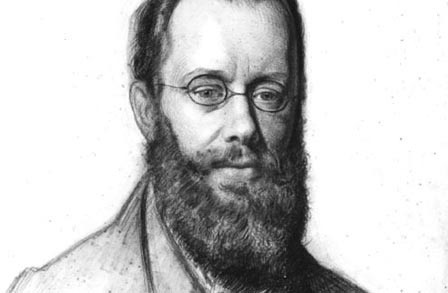Emily Dickinson- Among several poets writing in English in the nineteenth and twentieth centuries, Emily Dickinson is believed to present the most authentic cognitive difficulties in her poetry. Dickinson is said to have within her the flair and qualities of inventiveness, acquiring mastery in trope and craft, with an originality in her thoughts like Shakespeare and Freud. Emily Dickinson wrote most of her poems in the Dickinson Homestead on Main Street in Amherst, Massachusetts, a place where she was born in December 1830, and lived in virtual seclusion as an adult, and in May 1886, died. Dickinson never published her poems by her own, and therefore they may be seen as a private genre – her poetry can be said to be the replica of letters, that which she used as a means to communicate her personal thoughts with individuals. Dickinson composed over 1770 poems, but no one around had a clue that she was writing. The verses of hers explicitly belong to what Emerson since called “the Poetry of Portfolio,” that which were produced in entirety without the intention of the poet to get them published, and were exclusively the result of the writer’s own mind/ intellectual capacity. A recluse by temperament and habit, Dickinson literally spent years without setting her foot beyond the doorstep, in isolation. She has written verses in abundance, and though indifferent to all conventional rules, they are seen to have a meticulous literary standard.
Setting of This Is My Letter To The World-
Emily Dickinson’s “This is My Letter to the World,” believed to have been written in 1862, is an example of meta-poetry – poetry that is aware of itself as a poem, i.e to say it is self-reflexive in its nature and highlights how it is constructed and why it is being composed. The poem can even be seen as an epistolary preface to her works. The letter, here, can be read as a perfect metaphor, for it is an expressive, eloquent and effective means of communicating one’s thoughts or emotions, a medium through which one can have correspondence with one or many at the same time. Living a solitary life, without keeping any connection with the external world, a letter seemed to have served her the purpose of communication, a perfect channel through which she could express her innermost thoughts. An expression of intense personal and intimate urges, the poem demonstrates a need to express her private observations, reflections, and aspirations. It is her asceticism and solitude that made her probe the inner depths of life, and express those emotions realised in writing. As W.B. Yeats once wrote: “When we quarrel with others, we make rhetoric; When we quarrel with ourselves, we make poetry”.
In the poem, Dickinson appears to show resent towards her own social isolation; and a sense of resourcefulness is seen to pervade throughout regarding her ultimate reconciliation with the world and its Creator. Many critics have analysed the poem in religious context, since certain phrases/ words herein have been capitalised: “With tender Majesty”; “Her Message is committed”; “To Hands I cannot see,” suggesting that Dickinson is directly making a reference to God. The poem can even be understood as a desire from the poet’s side to be remembered fondly despite having walled herself off from the outside world (“Judge tenderly of Me”).
Poetic Devices in This Is My Letter To The World-
Slant rhymes: Words that do not rhyme exactly and uses dashes to highlight important words: “For love of Her- Sweet – Countrymen- “(7).
Personification: “The simple news that Nature told”(3), because nature by itself cannot speak. “Her message is committed/ to hands I cannot see”(5,6).
Apostrophe: “This is My Letter to the World” – here Dickinson is not exactly addressing herself to every single person in this world. At the same it can be noted that the world is absent in action, because it is not been talked about to have given any sort of feedback to the speaker.
Alliteration: “th” sound in “This is my letter to the World” (1).
Consonance: The ending “t” sound in “That never wrote to Me” (2).
At the beginning, Emily uses figurative language, which are words capitalised for emphasis: “This is my Letter to the World” (1).
Style-
Emily Dickinson is known for short, epigrammatic poems, that are revolutionary in both style and technique; and though precise in length, they illuminate a vast inner life of the poet. “This is My Letter to the World” serves as a typical example of her style, form, and voice. Like all her poems, it is untitled, known simply by its first line. It is a composition of two four-line stanzas, or quatrains, written in rhymed iambic tetrameter and trimeter lines, alternating with each other- a standard ballad form in which each line consists of six or eight syllables in an unstressed-stressed pattern. But Dickinson is seen implying innovation with this standard form: In the first line, she begins not with an iambic foot but with its opposite, a trochaic foot (stressed-unstressed), which emphasises the world “This”. A typical feature of her style is illustrated here, as she has dispersed the poem with dashes, that break up the flow of the lines and lend prominence to certain words.
Summary of This Is My Letter To The World-
The poem, presented by Dickinson in the form of a letter, as she mentions it in its very outset, is possibly addressed to the world, and it could be to the planet Earth or the whole universe, the reading public or the entire humankind. The greatness of this poem lies in the fact that not just a single meaning could be implied to its understanding; what is literally deciphered through the lines is only the surface explication, and a diversity to which it points at is commendable. It can be read as a narrative poem, through which the poet is trying to present herself to the zone, “the World,” that never seemed to have acknowledged her or her efforts. However, it can be noted that the poet is never overwhelmed by a feeling of contempt, or is disheartened. Even if the communication is seen to be one-sided, it continues un-reckoned. This poem is supposed to have been written at the time when Dickinson first began her career as a poet; and so it could even be read as an expression of the poet who is attempting to belong to this world. Nevertheless, Dickinson constantly detaches herself from the human race, being of the introvert nature.
The letter presented can metaphorically be seen to be the enclosed document which contains the experience of the artist who has lived a life of loneliness, and has been misunderstood throughout her lifetime. The concluding lines of the first stanza saying,”The simple News that Nature told-/ With tender Majesty,” possibly refers to what her letters contain. These lines clearly indicate the poet’s intentions, which is to transmit what she has learned from nature, the new knowledge, to the world around her. And this is what is desired by every great poet, to make the unknown world know the unaccomplished bounds through the poetic faculty of his/her mind or aesthetic capacity. The phrase used herein,”tender Majesty,” therefore, explicitly symbolises her desperation.
The second stanza begins with a reference to nature, that continues to indicate Dickinson’s dedication in writing poems about the nature she observes around. Thus, the nature seems to mean the logos, the divine power and the center, so to say according to the structuralists’ viewpoint, that acts as a guiding force to her. The nature, she believes, continues to give her inspirational wisdom, assisting her as the muse, in her writings. In other words it can be said that poetry is a medium through which the Nature communicates to the world; and in this respect, poet acts as an imitator. The “Hands” that the poet speaks of in the running line implies the hands of the future generation, the posterity, to which she would leave her legacy, her art, to be deciphered, that which could be of some meaning to their lives.
The concluding lines of the poem seems to a plea from the poet, who expresses her desire to the future generation, the “Sweet-countrymen,” to have a compassionate understanding of her letter. The poet makes this appeal in the name of the nature itself, for it is this Nature that has been an inspirational force in the course of her writing career. This appeal, however, sounds piteous; for it seems to predict a negative response from the reader’s side. The poem comes to an end with an earnest request to the reader to think of the speaker’s plight and to show mercy accordingly.
Critical Analysis of This Is My Letter To The World-
The sense of home, a place to which one primarily belongs, is indirectly established in the poem “This is my Letter to the World”. It is an evident reflection of the poet’s sense of place, her sense of belonging in her own secluded world and to her “Sweet countrymen”. The letter can be seen as an expression of the poet’s wish or desire to belong to the poetic pantheon. It suggests that the poet has a communion with the Nature, that speaks to her with kindness and generosity, acting as her guiding force. It is through her poetry that the Nature would speak to the humankind and, therefore, she expresses her desire to the future generation to have a compassionate and clear understanding of her letter, that which would act as a relic to them. Though the words used by the poet herein are simple and ordinary, they tend to pose difficulty in its crystal analysis; this is so because the poet by mixing the concrete with the abstract extends the meaning to a different realm or a new way of looking at the world.
Central Idea of This Is My Letter To The World-
One of the central ideas that pervades throughout the letter is the role of an artist to act as an imitator of the Nature and transmit the knowledge of the metaphysical world to the reader, to make him believe in the divine will of Nature that acts as a supervising force.
Tone of This Is My Letter To The World-
The tone of the poem is that of an acceptance, which is indicated by the line saying “To Hands I cannot see-/ for love of Her-Sweet-countrymen-/ Judge tenderly- of Me”(6-8).
Conclusion- “This is My Letter to the World” seems to be a poem whose implication and meaning remains in flux; there is no transcendental signified that can be attached to this signifier, so to say in the words of post-structuralists. Whether Dickinson is addressing this letter to the entire Universe, to the people around her, or the society at large reflects ambiguity, and this is what makes her poetic standard attain an acclamation. The poem encourages the reader to decipher the lines according to their understanding and draw their own conclusions; and in this sense her poetic piece can be drawn in line with the renowned dramatist Samuel Beckett’s work “Waiting for Godot”- that compels the reader to employ their literary intellectual capacity or otherwise to understand an absurdist text where nothing happens or proceeds, remains stagnant.
Some online learning platforms provide certifications, while others are designed to simply grow your skills in your personal and professional life. Including Masterclass and Coursera, here are our recommendations for the best online learning platforms you can sign up for today.
The 7 Best Online Learning Platforms of 2022
- Best Overall: Coursera
- Best for Niche Topics: Udemy
- Best for Creative Fields: Skillshare
- Best for Celebrity Lessons: MasterClass
- Best for STEM: EdX
- Best for Career Building: Udacity
- Best for Data Learning: Pluralsight
















